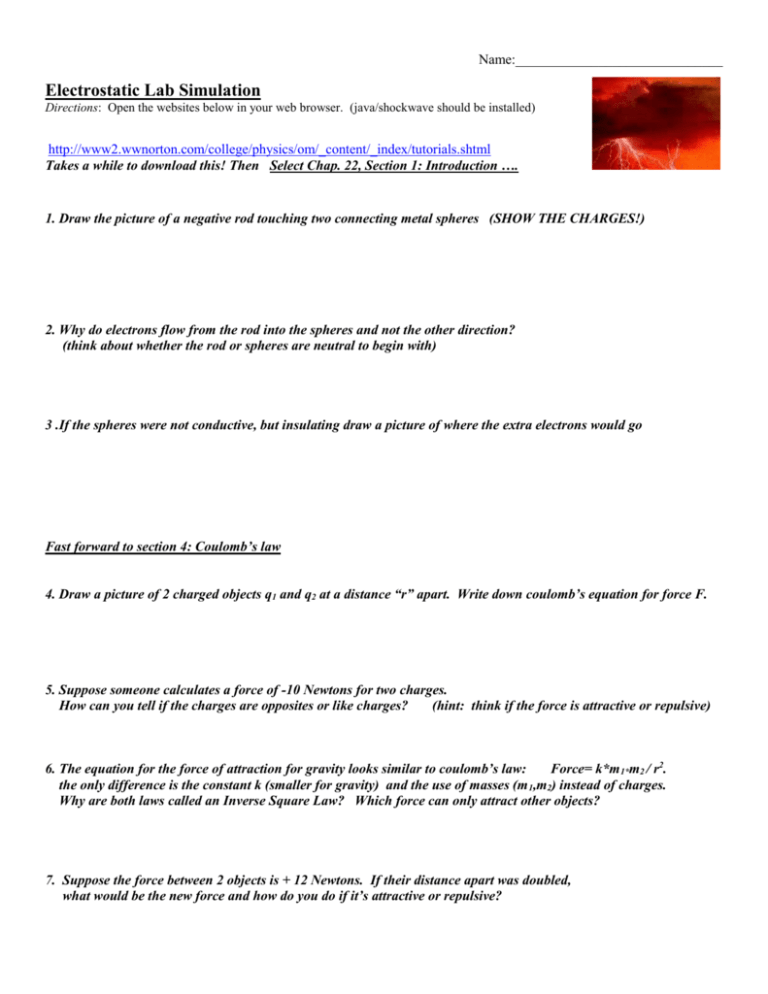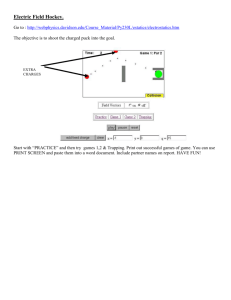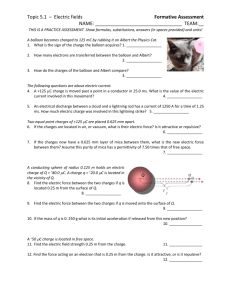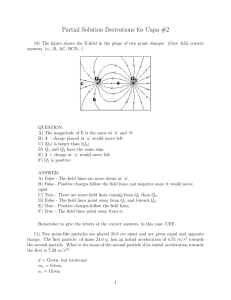Electrostatic Lab Sim New 2
advertisement

Name:______________________________ Electrostatic Lab Simulation Directions: Open the websites below in your web browser. (java/shockwave should be installed) http://www2.wwnorton.com/college/physics/om/_content/_index/tutorials.shtml Takes a while to download this! Then Select Chap. 22, Section 1: Introduction …. 1. Draw the picture of a negative rod touching two connecting metal spheres (SHOW THE CHARGES!) 2. Why do electrons flow from the rod into the spheres and not the other direction? (think about whether the rod or spheres are neutral to begin with) 3 .If the spheres were not conductive, but insulating draw a picture of where the extra electrons would go Fast forward to section 4: Coulomb’s law 4. Draw a picture of 2 charged objects q1 and q2 at a distance “r” apart. Write down coulomb’s equation for force F. 5. Suppose someone calculates a force of -10 Newtons for two charges. How can you tell if the charges are opposites or like charges? (hint: think if the force is attractive or repulsive) 6. The equation for the force of attraction for gravity looks similar to coulomb’s law: Force= k*m 1*m2 / r2. the only difference is the constant k (smaller for gravity) and the use of masses (m 1,m2) instead of charges. Why are both laws called an Inverse Square Law? Which force can only attract other objects? 7. Suppose the force between 2 objects is + 12 Newtons. If their distance apart was doubled, what would be the new force and how do you do if it’s attractive or repulsive? 2 The Triboelectric Series: http://www.glenbrook.k12.il.us/gbssci/phys/Class/estatics/u8l2a.html read the section about How Charging by Friction Works 8. Another name for charging by friction is called Triboelectricity. What does tribo mean? 9. If a certain material has a high “electron affinity”, does it have a high attraction or repulsion for electrons? 10. Find the tribo-electric series chart on the right side of the web page. Which materials has the strongest affinity for electrons?___________ the least______________ 11. Using the charge determine the charge (plus or minus) of the materials rubbed against another: a. rabbit fur_______ vs. rubber balloon________ (you should know this one already) b. cotton shirt_______ vs. human skin___________ c. glass window_______ vs. silk curtain____________ John Travoltage http://phet.colorado.edu/new/simulations/sims.php?sim=John_Travoltage …. Hit run now 12. Rub John’s foot on the carpet. Where does the charge come from? 13. Over time what happens to the excess charges in his body? 14. Ground John by touching his hand to the metal doorknob. So when a person gets shocked, what happens? (which charge moves) 3 Balloon Phun: http://phet.colorado.edu/new/simulations/sims.php?sim=Balloons_and_Static_Electricity ………………..hit run now……….. 15. Rub the balloon on the sweater. Why does the balloon want to keep close to the sweater? 16. Move the balloon near the wall. Draw a picture of the charges in the balloon & wall. What is the wall’s charge? 17. So when an object like the wall becomes polarized which charges move and why? The Electroscope: http://www.shep.net/resources/curricular/physics/P30/Unit2/electroscope.html 18. What is an electroscope? What is it used for? How does it work? 19. How do you charge an electroscope by contact (conduction)? – list the steps, draw a picture: 20. How do you charge an electroscope by induction? – list the steps, draw a picture showing the charges 21. Compare and Contrast charging by induction and conduction. a. which one requires grounding? b. which one ends up with the same charge as the charged source (stick)? c. which requires touching the electroscope by the charged source (stick)? d. which one requires you to separate the charges with the charged source (stick)? 4 Charging A Pith Ball With A Rubber Or Glass Rod: (see yes to open file) http://physics.weber.edu/amiri/director/dcrfiles/electricity/pithBallS.dcr 22. What is the charge on a pith ball after being touched by a glass rod? Rubber rod? What method of charging was used - induction or conduction? Losing Charge: http://www.regentsprep.org/Regents/physics/phys03/atheft/default.htm 23. How does a charged object lose its charge to the atmosphere? Lightning Phun: look at all three! http://micro.magnet.fsu.edu/electromag/java/lightning/index.html http://www.regentsprep.org/Regents/physics/phys03/alightnin/default.htm http://www.glenbrook.k12.il.us/GBSSCI/PHYS/CLASS/estatics/u8l4e.html 24. What causes lightning? Draw charges in clouds & the ground: 25. Which charge moves toward earth?________ Which charge move toward the clouds? ______ 26. What causes the thunder associated with lightning? 27. What happens to the build-up of charges during each lightning strike? 28. Clouds and the ground make-up a capacitor- 2 charged areas with a dielectric material in between. What is the dielectric material separating clouds and the ground? (rhymes with fair!) 5 Part II: The Electric Field: http://regentsprep.org/Regents/physics/phys03/afieldint/default.htm 1. In terms of the electric field produced by a charge, why does "it take one to know one"? 2. In the animation the electric field source charge is _____________. 3. A test charge is moved into the electric field. How does the force on the test charge relate to its distance from the source charge? 4. How does the simulation show the strength of the electric field on the test charge? 5. How does the simulation show the direction of the electric field on the test charge? 6. What is the charge on the test charge? (+ or -) __________ 7. Is the electric field a vector quantity? _________ is the electric force a vector quantity? ___________ 8. What two equations allow you to calculate the electric field intensity? Electric Field Mapping: http://www.glenbrook.k12.il.us/GBSSCI/PHYS/Class/estatics/u8l4c.html 1. Draw the electric field lines around a POSITIVE point charge. 2. Draw the electric field lines around a NEGATIVE point charge. 3. Draw the electric field lines around both a NEGATIVE and a POSITIVE point charge. 4. Draw the electric field lines around two POSITIVE point charges. 6 Visualizing Electric Field Lines: http://www.falstad.com/vector2de/ OR http://www.falstad.com/vector3de/ Choose Setup: point charge. Try using your mouse to rotate the field view as well as adjusting the Field Strength and Number of Particles. Make a sketch of the initial situation below and indicate the direction of the test particles flowing with arrows. What is the sign of the point charge? How do you know? What happens when you choose reverse? Conclusions about fields! 1. Field mapping will show the path followed by a _________ charge in an electric field. 2. Can field lines cross each other? _____ What is the significance when field lines are near each other? 3. Electric field lines begin or end only on _______________and go off to ________________. 4. Field lines move__________from positive charges and _______________a negative charge. 5. Larger charges (big magnitudes) have ____________field lines beginning or ending on them. They have a ________________ density of field lines around them. Just for phun…….. Exploring Electric Field Lines: Electric Field Hockey: Very Phun! http://www.colorado.edu/physics/phet/web-pages/simulations/electrichockey/webstart.jnlp







